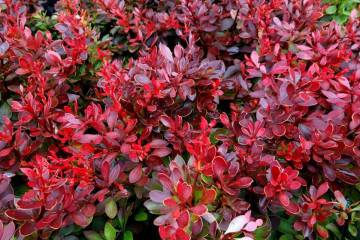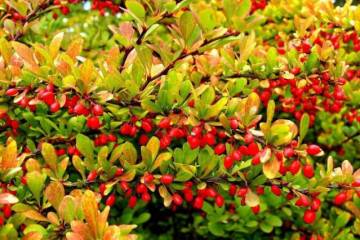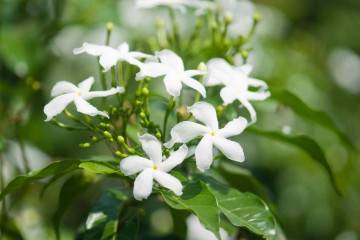Dogwood shrub and cotoneaster - planting and care
Content:
Dogwood is a tree or shrub. It belongs to the dogwood family. More than 50 types of culture have been studied. Among them are deciduous and evergreen. The name of the culture comes from the Turkic word "kizil", which means "red" in translation. Although there are species with fruits of various colors, they are predominantly red.
Dogwood - ornamental and fruit shrub
Dogwood is widespread wherever it is warm and sunny. It can often be found in Asia, some European countries, Africa, and the Black Sea regions.
In Russia, predominantly deciduous, tree-like dogwood-shrub grows. Gardeners cultivate it for the exceptional decorativeness of foliage and flowers. The stems with wine-red or bright yellow bark are interesting. It is also appreciated for its beneficial fruits.
The origin and appearance of the fruit shrub
The province of British Columbia is rightfully considered the birthplace of dogwood. He even became her official flower, like the states of Virginia and Missouri (USA).
The most widespread in these territories is the common dogwood (male). In height, the dogwood shrub grows up to 2-3 meters. Red-red weeping shoots give it a peculiar beauty.
Leaves can be arranged opposite or alternately. The color of the leaf plate is deep green. The bush lends itself well to crown formation. By the way, it can be shaped like a tree.
Dogwood tree or shrub belongs to the group of centenarians. Once planted, you can admire the beauty and get healthy berries for many generations, since dogwood trees have been growing in one place for about 200 years. By the age of 20, maximum fruiting is achieved - about 80 kg.
Description of flowers and fruits of dogwood
The dogwood begins to bloom in early May. Buds are small, milky white, collected in loose inflorescences. It takes about 2 weeks before fruit set. Fragrant flowers are very attractive to flying insects, so the pollination of the bush is almost 100%.
One- or two-seed fruits ripen from August to October. Depending on the variety, the berries have a different color, differ in size. The color of the fruits is predominantly red, but you can often find yellow, orange, purple, black, pink berries. Fruits of hybrid forms reach up to 3 cm in length.
The shapes of the berries are also different. There are:
- cylindrical;
- pear-shaped;
- spherical.
Types and varieties
Dogwoods are subdivided into 4 genera and 50 species. In Russia and the former republics of the USSR, 13 species are found.
Alyosha
The Russian variety Alyosha bears fruit with large yellow pear-shaped berries. Fruits, sweet with sourness, grow up to 9 g, fully ripen until September. The variety is distinguished by good productivity, transportability. It is frost-resistant, does not succumb to disease. Recommended for cultivation throughout Russia.
Elena
The early variety Elena begins to bear fruit in the summer. Its good property is that the berries reach full maturity in 4-6 days.The hybrid was created on the basis of highly frost-resistant varieties. He is not afraid of frosts down to -35 degrees. Elena is a high-yielder. Its fruits are bright red, juicy, cylindrical. All berries are homogeneous, weighing about 5 g.
Nikolka
Dogwood Nikolka is created on the basis of the Yantarny variety. Also very early. The fruits ripen by the end of July. Elongated, oval berries reach a weight of 8 grams. The pulp is juicy, with a delicate sweet, but slightly sour taste. The variety is frost-resistant (up to -30 degrees), transportable, resistant to diseases. The yield is high - about 35 kg per adult bush. The first fruiting occurs from 3-4 years of age. Can be grown throughout Russia.
Elegant
The Elegant variety is represented by a low tree. The height of an adult plant does not exceed 2 meters. The fruits ripen from the beginning of August. The weight of cherry fruits is not more than 5 g, the pulp is juicy, sweet and sour. The shape of the berries resembles a bottle with a narrow neck.
Transplant after purchase in open ground
A purchased seedling (at least 2 years old) is recommended to be planted no later than the end of September. The area should be shady. The soil is suitable with neutral acidity or slightly acidic. Wetlands are not suitable.
A pit for planting is dug 0.8x0.8 m in size. The soil mixture is enriched with humus and minerals. The root collar must remain on the ground. After planting, the bush is watered and mulched.
Propagation by cuttings
The most convenient for reproduction is considered to be cuttings. The material is cut from an adult plant (at least 5-6 years old). Cuttings 15 cm long are cut from healthy stems. They should have 2 pairs of leaves. The planting material is treated with a root formation stimulator ("Kornevin", "Epin") and planted on a nursery bed. For better rooting, it is recommended to create a greenhouse effect, but the ventilation of the plantings should be constant.
After 2-3 weeks, the roots will appear. You can start hardening the seedlings, that is, gradually begin to open them. The next fall, young plants can be planted in permanent places.
Outdoor care for dogwood
Caring for a garden dogwood is easy. Care consists of:
- watering;
- top dressing;
- loosening and weeding;
- pruning.
Watering is required abundant - up to 3 buckets per bush. The frequency depends on the weather. Fertilizers are applied in the spring with nitrogen, then potash and phosphorus. You can use organics.
Cotoneaster - decorative shrub
There is a plant very similar to dogwood - this is a cotoneaster. Only they belong to different families. The cotoneaster also has very attractive fruits. Shiny black or pink berries stay on the branch for a long time, decorating the shrub.
The origin and appearance of cotoneaster
Initially, the cotoneaster was described by the breeder K. Baugin from Switzerland. He gave it its name from the shape of the leaf plate. She resembles a quince. The culture is widespread in Africa, Asia, Europe. Due to its good frost resistance, it grows even in the territories of Siberia.
There are deciduous and evergreen varieties. Blooms in early spring with white or pink flowers. Ripe berries are apple-shaped and painted in colors such as:
- the black;
- red;
- Orange;
- coral.
Decorative properties of the cotoneaster
The cotoneaster shrub has an exclusively decorative purpose. Used to decorate gardens, parks. Looks good as a hedge. Attracts in the bush:
- changing the color of foliage - it turns red by autumn;
- beautiful multi-colored fruits.
Types and varieties
There are 80 varieties of this shrub. The most popular are described below.
Ordinary
Common cotoneaster is a deciduous shrub that grows up to 2 meters.A distinctive feature is the pubescence of the leaf plate from the seamy side. As a result, the foliage is dense green, and the seamy side is almost white. Also attractive are white inflorescences, spherical red berries. It tolerates frost and drought well.
Pressed
The pressed cotoneaster is more common in China. Prefers sunny mountain slopes. A distinctive feature of the species are branched crimson stems. The leaves are also very original - pointed, with a jagged edge. It blooms with pink small flowers, collected in inflorescences. The fruits are shiny, red.
Horizontal
The horizontal cotoneaster is a creeping variety. The bush does not exceed 0.3 m in height. But the whips are up to 2 m long. Depending on the climate, it can be deciduous or evergreen. The beauty of the bush is given by foliage. Casting dense green (burgundy by autumn) with a white border. The flowers are pale pink, the fruits are round, red.
Caring for cotoneaster in the garden
It is better to plant the cotoneaster before the beginning of autumn. It is preferable to choose 2-3 year old seedlings. Planting conditions are the same as for dogwood.
The plant is very unpretentious. Planting and caring for the cotoneaster bush consists only in choosing the required place, maintaining the desired crown shape and feeding. A drought-resistant plant needs almost no watering. From fertilizers, it is enough to use organic matter.
Ornamental shrub cotoneaster is propagated by cuttings. The method is no different from dogwood cuttings. Also, new bushes are often grown by rooting cuttings. Seeds collected from your bush are not recommended for propagation. The varietal qualities of the plant are unlikely to be preserved.
Both dogwood and cotoneaster are suitable for decorating the garden. Each culture has its own charm. Although dogwood is an ornamental shrub, it also has food value. The choice, as always, is up to the gardener.



















